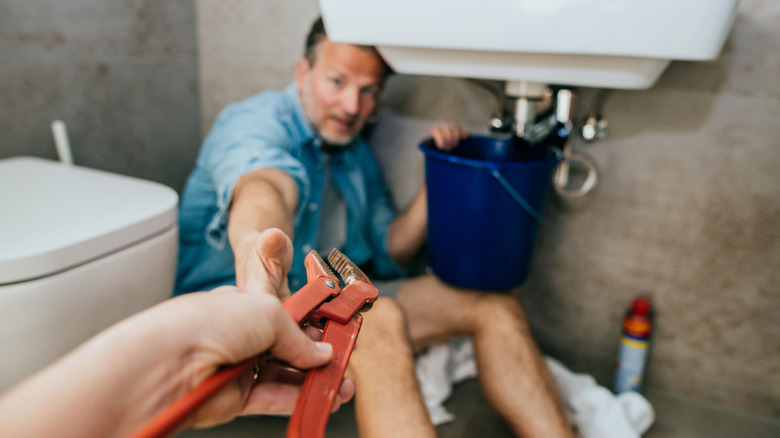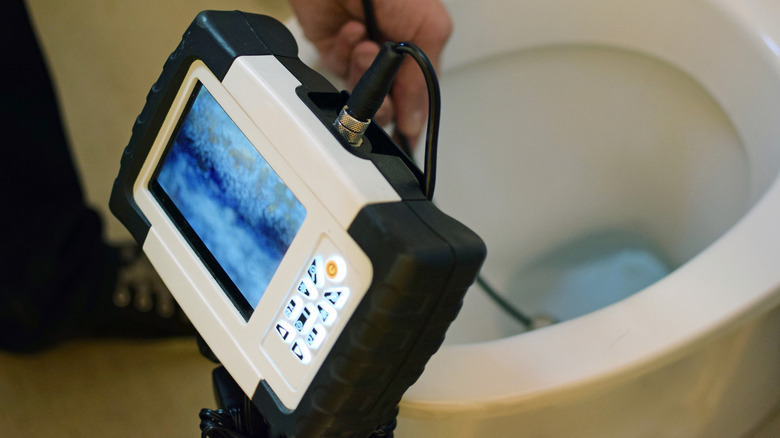Think Twice Before Tackling Drain Clogs And Leaks Without The Proper Equipment
When all you have is a hammer, your DIY plumbing job is not going to go well. Abraham Maslow formulated the notion that an over-reliance on common or familiar tools can make problems difficult to solve (put more simply: when all you have is a hammer, everything looks like a nail). But, with all due respect to Maslow, you can do an awful lot with a hammer. But precious little of it has to do with plumbing, which has its own specialized tools that you can't replace with whatever you have lying around.
Which isn't to say that you can't do plumbing tasks with a basic DIYer's toolkit. When Hunker spoke exclusively with Eddie Linares, Virtual Plumbing Expert at Frontdoor, about equipment for dealing with clogs and leaks, he said that clearing minor clogs, repairing leaking faucets, and replacing basic fixtures are all within the DIY-focused homeowner's repertoire. But for more complex tasks, you need to have the sorts of tools only a professional would have. And, often, only a professional is likely grasp the underlying complexities — water flow, venting, and materials, for example — required to diagnose the actual problem. Otherwise, you might end up treating the symptoms but not the actual cause of a clog or leak. "When you call in a professional – unless the problem is obvious – the first thing they will do is to run the water in the home to determine if a clog is in a single fixture or the result of a bigger problem," Linares said. Simply unclogging a drain isn't necessarily simple at all.
The right tools includes a lot of tools
About dealing with clogs and leaks, Linares exclusively told Hunker, "A professional will come equipped to make sure the job is done right." The urgency of even minor plumbing problems makes it critical to bring the right equipment to the job. "If you are dealing with a major leak or clog, sewage smells, low water pressure throughout the house, frozen pipes or major water damage or mold," Linares said, "it is best to call in a professional because these sorts of issues are usually the result of a bigger problem beyond a normal DIY fix."
Some plumbing jobs require not only specialized tools for making plumbing connections or clearing clogs, but also diagnostic equipment that the average homeowner isn't likely to have. "There is a lot of specialized drain cleaning equipment that your average homeowner does not have on hand," Linares said, "including electric powered snakes, jetting equipment and cameras." To make proper supply- and drain-line connections, you must be prepared to contend with many of the 18 or so types of pipe fittings, which requires quite a bit of special gear, from pipe wrenches in a huge range of sizes to the bits and bobs needed to solder or press certain types of fittings. If you're not regularly performing plumbing installs or repairs, there's no real reason you'd expect to have all the right tools on hand.
What could go wrong? Using the wrong tools will show you
If you don't do a plumbing repair promptly and properly, you risk everything from toxic mold that must be removed to floors collapsing under the weight of an unintended bedroom pond. "There are many potential risks that can lead to a bigger issue when trying to tackle any one of these jobs without professional tools," plumbing expert Eddie Linares told Hunker when we spoke with him exclusively. Unlike many DIY home improvement targets, water has a habit of moving around. "Some leaks can originate in one spot but show up in a completely different location," Linares said, "which can require opening sheetrock to find."
The tool gap is closely related to an experience gap. You probably don't own an endoscope camera for drain line inspection, or even know why you'd need one, because you simply haven't dealt with that many drain clogs. "Much of the risk comes from not being familiar with what you're working on and not knowing the proper steps to performing a successful repair," Linares explained. And that experience gap can make things worse. "For example," Linares continued, "with a clog, if you notice water come up in a sink, you may assume there is something stuck in the trap and try to disconnect the trap to clear it – only to realize it is a main line clog and water starts pouring all over the floor." It's the hammer and nail problem all over. Because you might have only dealt with clogged sink traps before, you bring that bias — and the associated tools — to the new leak.


